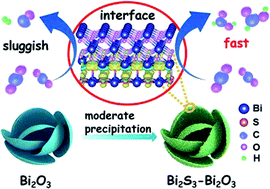当前位置:
X-MOL 学术
›
J. Mater. Chem. A
›
论文详情
Our official English website, www.x-mol.net, welcomes your
feedback! (Note: you will need to create a separate account there.)
Partial sulfuration-induced defect and interface tailoring on bismuth oxide for promoting electrocatalytic CO2 reduction†
Journal of Materials Chemistry A ( IF 10.7 ) Pub Date : 2019-12-18 , DOI: 10.1039/c9ta11363k Xuxiao Yang 1, 2, 3, 4, 5 , Peilin Deng 6, 7, 8, 9, 10 , Dongyu Liu 4, 5, 11, 12, 13 , Shuang Zhao 1, 2, 3, 4, 5 , Dan Li 1, 2, 3, 4, 5 , Hu Wu 1, 2, 3, 4, 5 , Yaming Ma 1, 2, 3, 4, 5 , Bao Yu Xia 6, 7, 8, 9, 10 , Mingtao Li 4, 5, 11, 12, 13 , Chunhui Xiao 1, 2, 3, 4, 5 , Shujiang Ding 1, 2, 3, 4, 5
Journal of Materials Chemistry A ( IF 10.7 ) Pub Date : 2019-12-18 , DOI: 10.1039/c9ta11363k Xuxiao Yang 1, 2, 3, 4, 5 , Peilin Deng 6, 7, 8, 9, 10 , Dongyu Liu 4, 5, 11, 12, 13 , Shuang Zhao 1, 2, 3, 4, 5 , Dan Li 1, 2, 3, 4, 5 , Hu Wu 1, 2, 3, 4, 5 , Yaming Ma 1, 2, 3, 4, 5 , Bao Yu Xia 6, 7, 8, 9, 10 , Mingtao Li 4, 5, 11, 12, 13 , Chunhui Xiao 1, 2, 3, 4, 5 , Shujiang Ding 1, 2, 3, 4, 5
Affiliation

|
Defect and interface engineering is a powerful strategy to tune the electronic structure and adsorption behavior of electrocatalysts, boosting the performance of the electrocatalytic CO2 reduction reaction (eCO2RR). Herein, we construct a hybrid electrocatalyst, Bi2S3–Bi2O3@rGO, with a large amount of defects (oxygen vacancies etc.) and a specific interface between bismuth sulfide (Bi2S3) and bismuth oxide (Bi2O3) by a partial precipitation conversion method. Both experimental results and theoretical calculations reveal that the Bi2S3–Bi2O3 interface drastically lowers the formation energy of HCOO*, in favor of the production of formate (HCOOH) over CO, promoting the conversion of CO2 to HCOOH. The as-prepared electrocatalyst shows excellent electrocatalytic activity to generate HCOOH with a high faradaic efficiency of over 90% and a low overpotential of 700 mV, as well as excellent durability for more than 24 h.
中文翻译:

局部硫化引起的缺陷和氧化铋的界面修整促进电催化CO 2还原†
缺陷和界面工程是调节电子催化剂的电子结构和吸附行为,提高电催化CO 2还原反应(eCO 2 RR)性能的有力策略。本文中,我们构建了一种混合电催化剂Bi 2 S 3 –Bi 2 O 3 @rGO,该催化剂具有大量缺陷(氧空位等),并且在硫化铋(Bi 2 S 3)和氧化铋(Bi)之间具有特定的界面。2 O 3)通过部分沉淀转化法。实验结果和理论计算均表明Bi 2S 3 -Bi 2 O 3界面极大地降低了HCOO *的形成能,有利于甲酸(HCOOH)的生成,而不是CO的生成,从而促进了CO 2向HCOOH的转化。所制备的电催化剂显示出优异的电催化活性,可产生HCOOH,其法拉第效率高达90%以上,低过电位为700 mV,并具有超过24小时的出色耐久性。
更新日期:2020-01-10
中文翻译:

局部硫化引起的缺陷和氧化铋的界面修整促进电催化CO 2还原†
缺陷和界面工程是调节电子催化剂的电子结构和吸附行为,提高电催化CO 2还原反应(eCO 2 RR)性能的有力策略。本文中,我们构建了一种混合电催化剂Bi 2 S 3 –Bi 2 O 3 @rGO,该催化剂具有大量缺陷(氧空位等),并且在硫化铋(Bi 2 S 3)和氧化铋(Bi)之间具有特定的界面。2 O 3)通过部分沉淀转化法。实验结果和理论计算均表明Bi 2S 3 -Bi 2 O 3界面极大地降低了HCOO *的形成能,有利于甲酸(HCOOH)的生成,而不是CO的生成,从而促进了CO 2向HCOOH的转化。所制备的电催化剂显示出优异的电催化活性,可产生HCOOH,其法拉第效率高达90%以上,低过电位为700 mV,并具有超过24小时的出色耐久性。











































 京公网安备 11010802027423号
京公网安备 11010802027423号